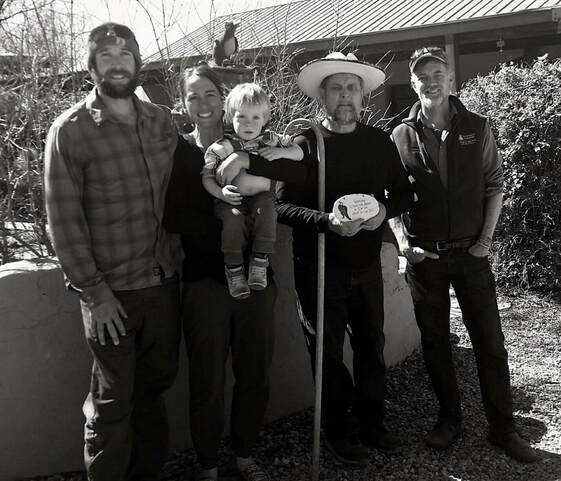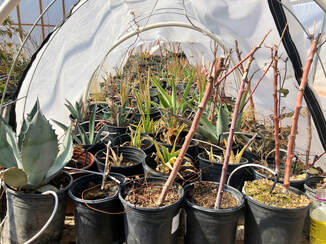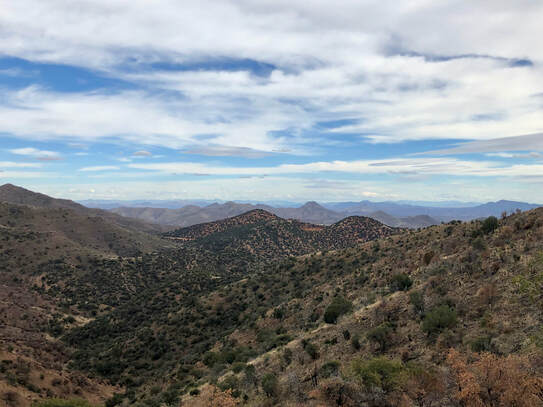Growing Food in a Hotter, Drier Land

Imagine an integrated system where edible annuals and perennials are interwoven with solar energy production. Now, imagine that this food and renewable energy producing system could improve the soil microbiome and harvest all water needs from rainwater off of the solar panels. Gary Nabhan is trialing this integrated system, known as agrovoltaic, in the Sonoran Desert where he lives and is seeing a 40 percent increase in yield of stevia, basil, and chiltepin Chili peppers planted under and around the solar panels. Instead of relying on center pivot and flood irrigation, he is using micro-aspersion, wicks, deeply buried clay pipes, porous capsule and micro-olla irrigation to efficiently transfer water to the root zone of plants better than any conventional form of drip irrigation.
I was excited to dive deeper into Gary’s thoughts about permaculture after reading his incredible book, “Growing Food in a Hotter Drier Land.” And after visiting his home recently, I see Gary is walking the talk and more, if possible, when it comes to doing just that. From a mere baseline of 5 food producing trees at his home, Gary is now growing over 130 fruit and nut trees, all with water-wise irrigation based off of his international journeys to discover how indigenous cultures grow food with little water.
When asked where he feels the permaculture momentum is taking us, Gary answered “I think it’s taking us back to how Thomas Jefferson thought about the world, that being a food producer is one of the highest intellectual callings that we could have. That we introduce plants, evaluate them, and share them with our neighbors. That we tell neighbors…what combination of plants work together in catastrophic years when we have flood or drought or freezes. So that we have a community of people that are sharing solid information with one another that is place-based. That’s why - even though permaculture has universal principles - all of it is about paying attention to the particulars of your place…I think its reminding people that universal theories that are like a drop-down formula imposed on the land are bound to fail. That we need to be attentive and see what the land needs.”
Before whisking me away for a tour of his home site, Gary ended his interview with, “Permaculture gives us the observational tools and then the pattern recognition - I really think it’s about thinking in patterns and thinking in whole systems that permaculture lends itself to better than anything else. It’s an observational process and thought process and then response with design. And I think – as you and I have already agreed – those design principles can be applied to any place and any scale of agriculture but first you have to know your place really well and build on the natural and cultural assets there. I think we skip over that in other ways of thinking about food production. So, in a very odd way, permaculture is an ideological movement as much as it is a humbling process where we see what is before us and dance with it.”

In addition to the book that deeply inspired me, Gary has written or served as primary editor for over a dozen books, with subjects ranging from “Ethnobiology for the Future: Linking Cultural and Ecological Diversity” to “Renewing America’s Food Traditions – Saving and Savoring the Continent’s Most Endangered Foods.” He also co-founded Native Seeds/SEARCH – a nonprofit conservation organization working to preserve place-based Southwestern agricultural plants as well as the knowledge of their uses – and served as founding director of the Center for Sustainable Environments at Northern Arizona University in Flagstaff, AZ. Now, Gary serves as a Kellogg Endowed Chair in Southwestern Borderlands Food and Water Security, founding the University of Arizona Center for Regional Food Studies. In working with the University of Arizona, Gary helped with the recognition of Tucson as the first UNESCO designated City of Gastronomy in the US, he received a Western Sustainable Agriculture Research and Education (SARE) grant to install over a dozen pollinator hedgerows, is researching climate change adaptation, phenology change and agrobiodiversity, and much, much more.
Regarding “Growing Food in a Hotter, Drier Land”, a writeup about the book by Alan Weisman (should you be inspired to learn more and dive into the book yourself) states “Nabhan, one of the world’s experts on the agricultural traditions of arid lands, draws from the knowledge of traditional farmers in the Gobi Desert, the Arabian Peninsula, the Sahara Desert, and Andalusia, as well as the Sonoran, Chihuahuan, and Painted deserts of North America to offer time-tried strategies, including:
- Building greater moisture-holding capacity and nutrients in soils;
- Protecting fields from damaging winds, drought, and floods;
- Reducing heat stress on crops and livestock;
- Harvesting water from uplands to use in rain gardens and terraces filled with perennial crops;
- Selecting fruits, nuts, succulents, and herbaceous perennials that are best suited to warmer, drier climates; and,
- Keeping pollinators in pace and in place with arid-adapted crop plants.”
To discover more about Gary, his books, and his work with the University of Arizona and beyond, visit: https://www.garynabhan.com

Recent Posts

